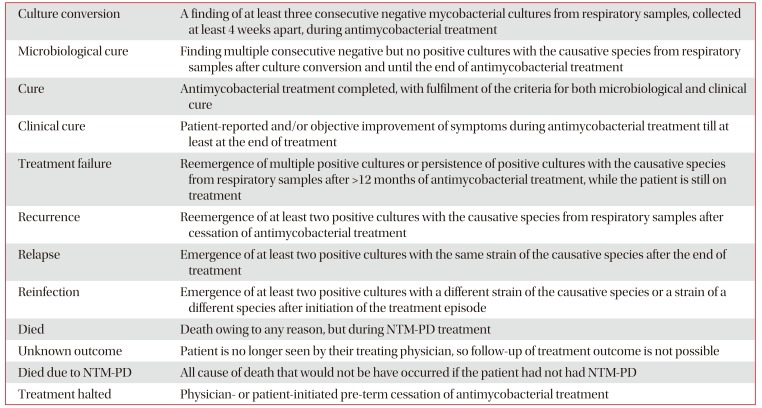The below items will be collected.
1) At the time of enrollment
(1) Demographic information: age, sex, body mass index, smoking status (never/former/current), previous history of TB.
(2) Laboratory findings: white blood cell count (/mm3), hemoglobin (g/dL), platelet count (/mm3), erythrocyte sediment rate (mm/h), total protein (g/dL), albumin (g/dL), total bilirubin (mg/dL), alkaline phosphatase (IU/L), aspartate transferase (IU/L), alanine transferase (IU/L), blood urea nitrogen (mg/dL), creatinine (mg/dL).
(3) Functional capacity and health-related quality of life (HRQL): post-bronchodilator forced expiratory volume at 1 second (FEV1), post-bronchodilator forced vital capacity (FVC), FEV1/FVC, diffusing capacity for carbon monoxide (DLCO), 6-minute walking test, St. George Respiratory Questionnaire and Hospital Anxiety and Depression Scale (HADS).
(4) Comorbidities:
- Respiratory comorbidities: chronic obstructive pulmonary disease, asthma, interstitial lung disease, bronchiectasis, chronic pulmonary aspergillosis, lung cancer, and other respiratory diseases.
- Non-respiratory comorbidities: diabetes mellitus, rheumatologic diseases (including rheumatoid arthritis, systemic sclerosis, and lupus), chronic liver disease, chronic kidney disease, cardiovascular diseases (including myocardial infarction, angina, stroke, transient ischemic attack, pulmonary hypertension and atrial fibrillation), human immunodeficiency virus infection, immunosuppressant use (including transplant recipients) and malignancy (diagnosed within 5 years from the time of enrollment).
(5) Symptoms at the time of treatment initiation: cough (none, present when having upper respiratory infection, frequently coughing or daily coughing), sputum (expectorate everyday, expectorate >4 days per week, expectorate <3 days per week, or rarely), hemoptysis, weight loss (more than 10% of body weight within the past 12 months), and dyspnea (using the Modified Medical Research Council scale).
(6) Radiographic features present on chest computed tomography (CT) scans at the time of treatment initiation (CT scans performed within 3 months before treatment initiation or 1 month after treatment initiation will be reviewed):
- Type: nodular bronchiectatic, fibrocavitary, and unclassified (including consolidation or solitary nodule).
- Presence of cavity: the presence of cavity and the longest diameter on axial view will be collected irrespective of radiographic type. If the number of cavities is two or more, the size will be measured from the largest one.
(7) Bacteriologic results:
- Date of initial diagnosis.
- Source of NTM isolation: sputum/bronchial washing or alveolar lavage/tissue.
- Smear status: negative/trace/1+/2+/3+/4+.
- Etiologic organism: M. avium/M. intracellulare/other MAC/M. abscessus subsp. abscessus/M. abscessus subsp. massiliense/M. kansasii/co-infection.
- Drug susceptibility test: presence of resistance (including inducible resistance) and minimal inhibitory concentration will be provided.
(8) Reasons for treatment initiation:
- Symptomatic aggravation: cough/sputum/hemoptysis/dyspnea/weight loss.
- Radiographic aggravation: bronchiectasis/nodule/consolidation/atelectasis/cavity/ground glass opacity.
(9) Initial treatment regimen:
- Dosing schedule: daily or thrice weekly.
- Initial regimen: clarithromycin/azithromycin/amikacin (intravenous/intramuscularly/inhaled)/rifampin/ethambutol/tigecycline/clofazimine/cefoxitin/imipenem/ciprofloxacin/moxifloxacin/linezolid/other.
- Date of treatment initiation.
2) At follow-up after treatment initiation
- Drugs prescribed at each visit: clarithromycin/azithromycin/amikacin (intravenous/intramuscularly/inhaled)/rifampin/ethambutol/tigecycline/clofazimine/cefoxitin/imipenem/ciprofloxacin/moxifloxacin/linezolid/other.
- Drugs discontinued at each visit.
- Adverse events leading to the discontinuation of drugs: the discontinuation of certain drugs is decided by duty physicians' judgement and will be described on medical records.
- Specific adverse events: nausea/vomiting/diarrhea/azotemia/elevated aspartate aminotransferase or alanine transaminase/hearing impairment/peripheral neuropathy/rash or itching/skin pigmentation/other.
- Mycobacterial culture results.
- Drug susceptibility test results every 6 months if negative culture conversion is not achieved.
- Adoption of adjunctive surgery: wedge resection/segmentectomy/lobectomy (including lobectomy+wedge resection)/lobectomy+segmentectomy/bilobectomy/pneumonectomy/other.
- Recurrence or reinfection, if confirmed.
- Functional capacity and HRQL evaluation (at 6-month intervals): post-bronchodilator FEV1, post-bronchodilator FVC, FEV1/FVC, DLCO, 6-minute walking test, St. George Respiratory Questionnaire, and HADS.





 PDF
PDF ePub
ePub Citation
Citation Print
Print



 XML Download
XML Download